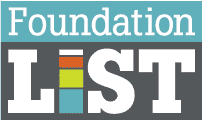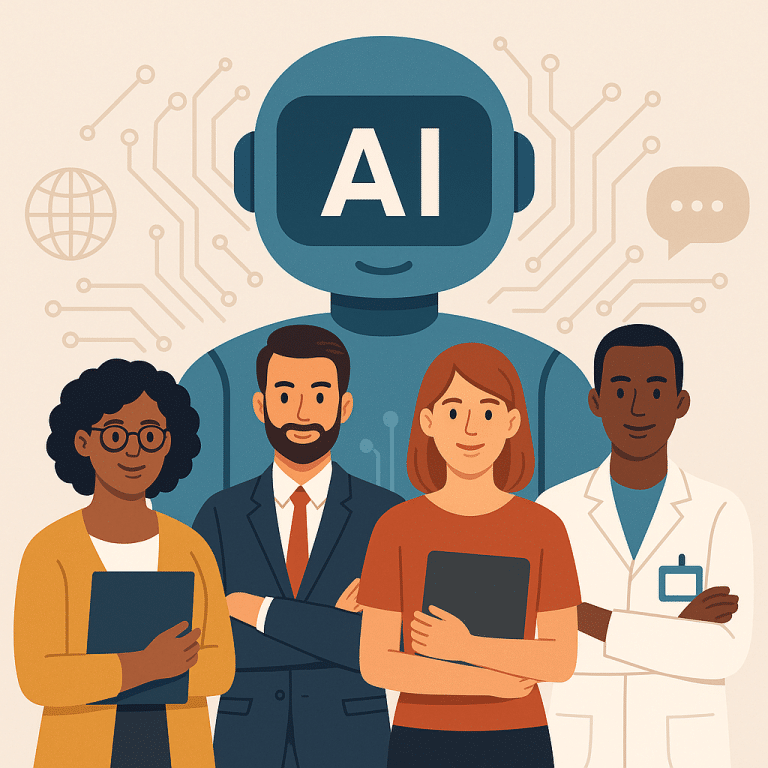Artificial intelligence is no longer a futuristic concept. It’s here, and it’s reshaping how nonprofits operate, communicate, and grow. In this blog, we explore how AI is revolutionizing nonprofit operations from the inside out. You’ll discover the most impactful tools nonprofits are using today, including a curated list of 40 AI platforms for content creation, fundraising, grant writing, and more. We also take a look at the rise of AI-powered agents, the emergence of new mission-aligned tech roles, and the evolving job market across nonprofit, healthcare, and education sectors. Whether you’re a nonprofit leader, staff member, or job seeker, this guide will help you stay ahead of the curve and confidently navigate the future of work.
How AI Is Transforming Nonprofit Operations
Artificial intelligence is rapidly changing how the world works, and nonprofit organizations are no exception. From donor engagement and communications to internal operations and grant writing, AI is opening new doors for efficiency, creativity, and reach—and it’s more accessible than ever before.
In this post, we’ll explore the leading AI tools nonprofits are using, showcase top free resources, define 40 of the most commonly used AI tools across different nonprofit functions, and examine how these technologies may impact the job market across the nonprofit, healthcare, and education sectors.
How AI Is Reshaping Jobs in Nonprofit, Healthcare & Education Sectors
Artificial intelligence is no longer a distant concept—it’s already reshaping the way work gets done across mission-driven organizations, medical systems, and educational institutions. As AI becomes more integrated into daily operations, the workforce landscape is beginning to shift in significant ways. While some repetitive tasks may become automated, new opportunities are also emerging for professionals who understand and adapt to these powerful tools.
Evolving Roles and Growing Demand
AI is set to transform roles across sectors, not by eliminating people, but by changing what roles look like. Here are a few key trends to watch:
- Administrative automation is streamlining repetitive workflows—think data entry, scheduling, and document processing. This may reduce the need for certain entry-level roles, while opening doors for new tech-assisted administrative positions that require AI fluency.
- AI-literate professionals are quickly becoming essential across functions like communications, development, and marketing—especially those who can create, edit, and optimize content using AI.
- Emerging specialties such as prompt engineering, algorithm oversight, and digital ethics are taking shape, creating entirely new categories of employment.
- In healthcare, AI is accelerating diagnosis, recordkeeping, and patient communication—helping free up clinicians to focus more on human-centered care.
- In education, AI-powered tools are assisting with lesson planning, tutoring, and curriculum customization. Yet, human educators continue to play a crucial role in emotional support, mentorship, and contextual instruction.
Where the Job Growth Is Happening: The New Frontier of AI-Driven Roles
As AI continues to reshape how work is done, it’s also creating exciting new career paths—especially for professionals who can bridge the gap between technology and mission-driven goals.
We’re seeing a wave of hybrid roles emerge—positions that require both technical fluency and a deep understanding of organizational values, communications, or community impact. These aren’t just jobs for engineers—they’re opportunities for forward-thinking professionals who want to lead in the age of intelligent tools.
Key growth areas include:
- AI implementation specialists – Professionals who help integrate AI into nonprofit, healthcare, or educational workflows and ensure tools are used efficiently and ethically.
- Data analysts – Experts who can extract insights from large datasets to inform decisions on programming, fundraising, and operations.
- Digital fundraising strategists – Creatives who leverage AI for donor targeting, campaign optimization, and personalized messaging.
- Hybrid communication + tech roles – New positions that blend storytelling, social media, and AI-assisted content creation.
- Ethics and compliance professionals – Leaders who ensure responsible AI use, maintain data privacy, and align automation with organizational standards.
These roles are shaping a future where technology doesn’t replace human purpose—it amplifies it. For job seekers, it’s a chance to future-proof their careers. For employers, it’s a call to rethink job descriptions and invest in talent that’s ready to grow with the field.
The Rise of AI Agents in Nonprofits: Your New Digital Coworkers
AI agents are quickly becoming indispensable digital teammates in the nonprofit world—quietly working behind the scenes (and sometimes front and center) to streamline operations and boost capacity.
Rather than replacing staff, these tools are taking on repetitive, time-consuming tasks, freeing up teams to focus on strategy, relationships, and high-impact work. Here’s how they’re already making a difference:
- AI chatbots are now handling common donor and volunteer questions, providing instant answers around the clock for FAQs, event registrations, and volunteer signups.
- Voice agents are supporting hotlines by quickly routing calls, answering basic queries, and helping crisis response teams manage high volumes of urgent requests.
- AI grant-writing agents can gather organizational data, draft compelling proposal narratives, and generate customized messaging—often with minimal human input.
These agents aren’t just tools—they’re becoming digital coworkers. Whether working fully autonomously or assisting in tandem with staff, they’re helping nonprofit teams save time, reduce burnout, and stay mission-focused in an increasingly fast-paced world.
As these technologies continue to evolve, organizations that explore their use early are better positioned to adapt, grow, and serve their communities with greater agility.
40 Commonly Used AI Tools Across Nonprofit Functions
Generative Writing & Content
- ChatGPT – Conversational AI for writing, research, and brainstorming.
- Jasper – AI content creator for blogs, ads, and social media.
- Copy.ai – Tool for marketing and copywriting automation.
- Grammarly – AI-enhanced writing assistant and grammar checker.
- Writesonic – AI content generator with SEO tools.
- Notion AI – Workspace tool with AI for notes, writing, and task management.
- Quillbot – Paraphrasing and summarization tool.
- Wordtune – AI writing enhancement platform.
- Sudowrite – AI co-writer for long-form content.
- Anyword – AI copywriting optimized for conversions.
Grant Proposal Creation 11. Grantable – AI-powered grant writing automation. 12. Fundwriter.ai – AI platform for donor communication and proposal creation. 13. Instrumentl – Grant research and management platform with AI insights. 14. Elevate – Consulting firm using AI for impact communications. 15. Grammarly Business – Grammarly for team-wide proposal editing and clarity.
Design & Branding 16. Canva Magic Design – Instant design templates using AI. 17. Adobe Firefly – AI for image generation and design tools. 18. Looka – AI logo maker and brand identity designer. 19. Designs.ai – AI suite for logo, video, and banner creation. 20. Khroma – AI color palette generator.
Video & Audio Creation 21. Pictory – Turns text into videos using AI. 22. Lumen5 – AI video creation from blog posts and articles. 23. Descript – AI-powered video and podcast editing. 24. Synthesia – AI avatars and voice for video production. 25. RunwayML – Creative video editing and AI generation.
Social Media Content & Scheduling 26. Buffer AI Assistant – AI-generated post suggestions. 27. Hootsuite OwlyWriter – Social content AI for marketers. 28. Predis.ai – AI social media post creator and scheduler. 29. Later – Visual social media planner with AI features. 30. Canva Magic Write – AI-powered copy for social posts.
Fundraising & CRM 31. Salesforce Einstein – Built-in AI for fundraising insights. 32. Bloomerang AI Insights – AI to predict donor retention. 33. Kindful – Donor management software with automation features. 34. DonorSearch AI – Wealth screening and donor prospecting with AI. 35. Fundraise Up – AI-powered donation platform.
AI Agents & Automation 36. Zapier AI – Workflow automation with AI recommendations. 37. Chatbot.com – Custom AI chatbots for websites. 38. Kore.ai – AI virtual assistants for customer experience. 39. Cognigy – Conversational AI for service automation. 40. Levity AI – AI for automating document workflows.
Top Free AI Tools for Nonprofits
When it comes to accessible, high-impact AI for nonprofits, three standout tools are transforming how teams work: ChatGPT by OpenAI, Google’s Bard (now evolving into Gemini), and Meta’s Meta AI. Each brings unique strengths to donor communications, content creation, and daily operations.
🧠 ChatGPT by OpenAI (chat.openai.com)
- What it does: A conversational AI chatbot that drafts emails, grant proposals, social content, summarises reports, and brainstorms ideas.
- Why nonprofits love it: Its intuitive text-based interface lets staff quickly turn prompts into polished writing. Great for handling both creative brainstorming and administrative tasks—without a steep learning curve.
🌐 Google Bard / Gemini (gemini.google.com)
- What it does: A conversational AI built on Google’s LaMDA and PaLM models, integrated with Google Workspace—including Gmail, Docs, Drive, and YouTube.
- Nonprofit applications:
- Automatically draft content using your own resources (e.g., “pull donor email templates from Drive and update them for a spring campaign”).
- Generate fundraising email drafts, social posts, or strategic outlines.
- Integrate AI into Google Ad Grants and Smart Bidding campaigns—optimizing ads, keyword selection, and yield from donated ad budgets
- Edge over others: Deep integration with Google tools means Bard/Gemini can pull from your own documents and data—making it context-aware and deeply useful for nonprofit-specific workflows.
🤖 Meta AI (aka Facebook’s AI assistant)
- What it does: A conversational assistant powered by Llama 4 (Meta’s large language model), embedded in a standalone app and across Facebook, Instagram, WhatsApp, Messenger, and Ray‑Ban smart glasses
- Creative highlights:
- Includes generative video editing with over 50 presets—perfect for event clips, recruiter outreach, volunteer stories, or campaign content
- Multilingual: can craft content and respond in the languages your supporters use—right in social media inboxes or chats.
- Evolves as a personal assistant tied to your social presence and internal scheduling.
- Key advantage: Effortless integration with Meta’s massive social platforms. It’s built for rapid deployment: quickly generate social-first videos or engaging FB/IG chat interactions—ideal for real-time campaigns or storytelling.
Nonprofit Action Tips:
- Start small: Use ChatGPT for email drafts and donor outreach.
- Then integrate: Add Bard/Gemini to access and repurpose your Google docs/campaign assets.
- Use visuals: Try Meta’s video presets for social storytelling—test one per month.
- Iterate: Compare outputs and workflows quarterly to refine your AI toolkit.
By experimenting across these tools, organizations can discover the right mix of creative output, operational impact, and engagement value—without overloading their teams or budgets.
How Nonprofits Can Stay Ahead of the Curve
AI is moving fast—but getting started doesn’t require a massive overhaul. Here’s how forward-thinking organizations can begin embracing it now:
- Experiment with free tools. Platforms like ChatGPT and Canva’s AI features are excellent entry points for tasks like content generation, grant writing support, and design.
- Support AI upskilling. Encourage your team to explore short, free courses in AI basics. Websites like Coursera, Udemy, and edX offer great introductions to AI concepts.
- Start small with integration. Choose one or two key areas—such as donor outreach, email campaigns, or report drafting—and pilot an AI tool to improve efficiency.
- Review roles regularly. As your team adopts AI, it’s smart to periodically update job descriptions to reflect evolving responsibilities and skill needs.
💡 A helpful mindset: “AI won’t replace your job—but someone using AI might.”
By exploring AI tools and building internal fluency now, nonprofits, schools, and healthcare providers can not only stay relevant—but increase their capacity, impact, and innovation well into the future.


